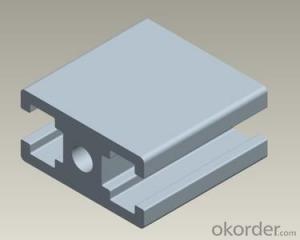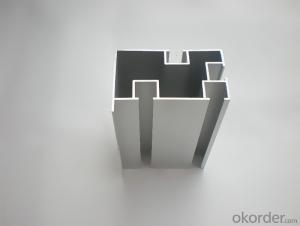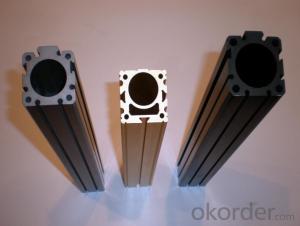Aluminum 6063 T5 Extrusion
- Loading Port:
- China Main Port
- Payment Terms:
- TT OR LC
- Min Order Qty:
- -
- Supply Capability:
- -
OKorder Service Pledge
OKorder Financial Service
You Might Also Like
Aluminium is a relatively soft,durable, lightweight, ductile and malleablemetal with appearance ranging from silvery to dull gray,depending on the surface roughness. It is nonmagnetic and does not easilyignite. A fresh film of aluminium serves as a good reflector (approximately92%) of visible light and an excellent reflector (as much as98%) of medium and far infrared radiation. The yield strength of pure aluminium is 7–11 MPa,while aluminium alloys have yield strengths ranging from200 MPa to 600 MPa. Aluminium has about one-third the density and stiffnessof steel. It iseasily machined,cast, drawn and extruded.
Aluminum Profile
Material | Alloy 6063,6061,6005or according to customer’s choice |
Temper | T3, T4, T5, T6 |
Surface | Anodize, electrophoresis, powder coating, PVDF coating, wood grain painting, matted, etc. |
Length | Coating 6.5 meters, Anodizing 6.5 meters, Mill finish 5 meters |
Application | Industrial, electrical equipment(TV set, air conditioner, refrigerator, computer), decoration,construction, transportation |
Custom Made | We can package following with customer's request. |
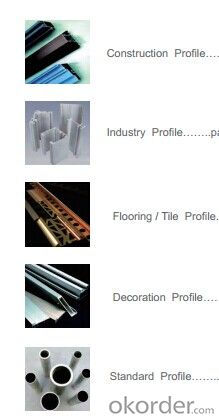
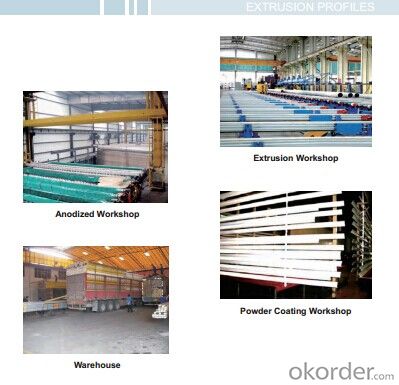
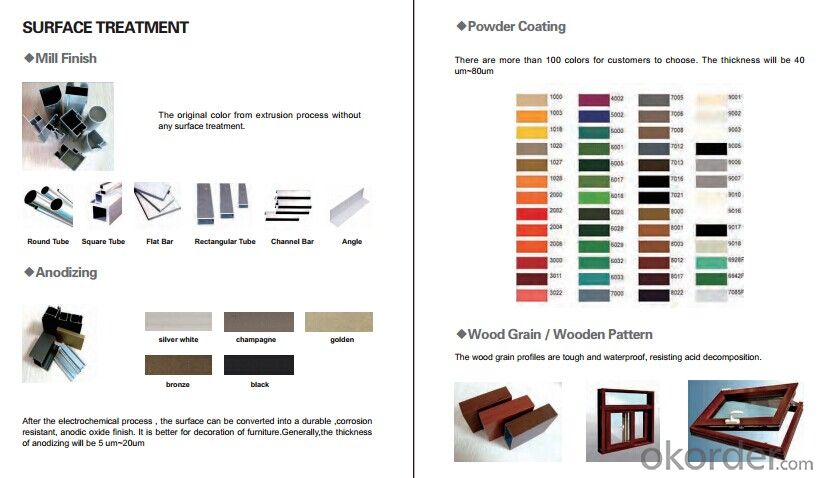
- Q:Can aluminum profiles be used for retail displays?
- Yes, aluminum profiles can be used for retail displays. Aluminum profiles are lightweight, durable, and can be easily customized to fit various display needs. They provide a sleek and modern look, making them ideal for showcasing products in a retail setting. Additionally, aluminum profiles can be easily assembled, disassembled, and reconfigured, allowing for flexibility and adaptability in creating appealing retail displays.
- Q:Can aluminum profiles be anodized for improved corrosion resistance?
- Yes, aluminum profiles can be anodized for improved corrosion resistance. Anodizing is an electrochemical process that forms a protective layer of aluminum oxide on the surface of the metal. This layer not only enhances the appearance of the aluminum profile but also provides excellent corrosion resistance properties. During the anodizing process, the aluminum profile is immersed in an electrolytic solution and a direct current is applied. This causes oxidation to occur at the surface of the metal, resulting in the formation of a thick layer of aluminum oxide. This oxide layer is hard, durable, and tightly adheres to the underlying aluminum, providing a barrier against corrosion. The anodic oxide layer can further be enhanced by sealing it with various sealing methods, such as hot water sealing or chemical sealing. This helps to increase the resistance of the anodized aluminum profile against environmental factors like moisture, chemicals, and UV radiation. Anodized aluminum profiles have several advantages over non-anodized ones. They have improved resistance to corrosion, scratches, and wear. Additionally, anodizing can also provide the aluminum profile with a decorative finish, as it allows for a wide range of colors to be applied. Overall, anodizing is a highly effective method to enhance the corrosion resistance of aluminum profiles, making them suitable for various applications where protection against corrosion is essential, such as in construction, automotive, aerospace, and electronics industries.
- Q:What are the benefits of using aluminum profiles in interior design?
- There are several benefits of using aluminum profiles in interior design. Firstly, aluminum profiles are highly versatile and can be used in a wide range of applications. They can be easily customized and fabricated to fit different design requirements. Whether you are designing a modern, minimalist space or a traditional, ornate interior, aluminum profiles offer a flexible solution. Secondly, aluminum profiles are lightweight yet durable, making them an ideal choice for interior design. They are resistant to corrosion, moisture, and temperature changes, ensuring a long lifespan. This durability also means that aluminum profiles require minimal maintenance, saving both time and money in the long run. Another benefit of using aluminum profiles is their aesthetic appeal. They come in a variety of finishes, colors, and textures, allowing designers to achieve their desired look and feel. Aluminum profiles can be anodized, powder-coated, or polished, giving them a sleek and modern appearance. They can also be designed to mimic other materials, such as wood or stainless steel, while offering the added benefits of aluminum. Additionally, aluminum profiles offer excellent thermal and acoustic insulation properties. They can help regulate temperature and reduce noise levels, creating a more comfortable and peaceful environment. This is especially beneficial in areas where soundproofing or energy efficiency is required, such as offices, hotels, or residential spaces. Lastly, aluminum profiles are eco-friendly and sustainable. Aluminum is a highly recyclable material, and using aluminum profiles in interior design helps reduce waste and minimize environmental impact. Moreover, aluminum profiles can contribute to energy efficiency by allowing natural light to enter a space, reducing the need for artificial lighting during the day. In conclusion, the benefits of using aluminum profiles in interior design are versatility, durability, aesthetic appeal, thermal and acoustic insulation, and sustainability. These qualities make aluminum profiles a popular choice among designers and architects looking to create functional and visually appealing spaces.
- Q:Aluminum bending die, iron must be used, what iron should be used, specifically what brand?
- General production of aluminum alloy is H13, die steel, if stretched or squeezed, most are carbide. I work in the production of aluminum profiles
- Q:Xi'an XAC aluminum sales site.
- Chongqing aluminum is also good ah, Dadukou there
- Q:I would like to know where Urumqi has industrial aluminum profiles, such as 3030, 4040, 3060 aluminum, etc., note that industrial aluminum, not doors and windows, aluminum profiles, the difference between the two very large!
- And shares in the east railway station there, the east railway station and then go one Station Road (near the North Main Road) can see.
- Q:What is the difference between 6061-T6 and 6063-T6 in aluminum profile?
- For example, Si ingredients: 6061 is 0.4 - 0.8; 6063 is 0.2-0.6. iron ingredients: 6061 is 0.7; 6063 is 0.35., etc.
- Q:Are there any special considerations for installing aluminum profiles?
- Installing aluminum profiles involves several important considerations. To begin with, proper alignment and leveling of the profiles during installation is crucial. This is necessary to achieve a seamless and professional appearance. Tools such as laser levels or spirit levels can assist in this process. Next, it is vital to use the appropriate type and size of fasteners for securing the profiles. Stainless steel or aluminum screws and rivets are commonly used due to their corrosion resistance and ability to provide a secure hold. Additionally, pre-drilling holes in the profiles is important to prevent cracking or splitting. Another factor to consider is the expansion and contraction of aluminum caused by temperature changes. Aluminum has a high coefficient of thermal expansion, so leaving enough space for the profiles to expand and contract without causing damage is necessary. This can be achieved by creating a small gap between the profiles during installation. Moreover, the weight and load-bearing capacity of the profiles need to be taken into account. If the profiles are intended to support heavy loads or structural components, additional support or reinforcement may be required. Lastly, it is crucial to carefully follow the manufacturer's instructions and guidelines for installation. Each type of aluminum profile may have specific requirements, such as recommended installation techniques or maximum spans between supports. Adhering to these guidelines will ensure a safe and secure installation. In conclusion, installing aluminum profiles necessitates careful attention to alignment, fasteners, expansion and contraction, load considerations, and adherence to manufacturer's instructions. By considering these factors, one can ensure a successful and durable installation.
- Q:Can aluminum profiles be used for greenhouse construction?
- Indeed, greenhouse construction can make use of aluminum profiles. The durability, lightweight characteristics, and corrosion resistance of aluminum make it a favored selection for greenhouse frames. Moreover, aluminum proves to be easily manageable, enabling flexibility in design and construction. The utilization of aluminum profiles yields a robust and steady structure capable of enduring severe weather conditions and providing enduring support for greenhouse coverings. Furthermore, aluminum frames necessitate minimal upkeep and possess a lengthier lifespan in comparison to alternative materials, rendering them a cost-efficient choice for greenhouse construction.
- Q:How do I maintain and clean aluminum profiles?
- Achieving and upholding the cleanliness and maintenance of aluminum profiles can be accomplished by adhering to the following guidelines: 1. Consistent dusting is key: Commence by employing a gentle cloth or feather duster to eliminate loose dust or dirt. This will hinder the accumulation of grime and simplify the subsequent cleaning process. 2. Create a cleaning solution: Combine warm water with a mild detergent or dish soap in either a bucket or spray bottle. It is important to avoid the usage of harsh chemicals or abrasive cleaners, as they have the potential to cause damage to the aluminum surface. 3. Thoroughly clean the profiles: Immerse a soft cloth or sponge into the cleaning solution and delicately scrub the aluminum profiles. Particular attention should be given to areas that exhibit stains or stubborn dirt. 4. Rinse with fresh water: Subsequent to cleaning, it is crucial to thoroughly rinse the profiles with clean water to eliminate any residual soap or cleaning solution. This step is essential in preventing the formation of streaks or marks caused by dried residue. 5. Dry the profiles: Employ a soft, dry cloth or towel to meticulously wipe the aluminum profiles until they are completely dry. This will help prevent the formation of water spots and preserve the metallic shine. 6. Optional polishing: If desired, a non-abrasive aluminum polish can be applied to further enhance the shine and safeguard the surface. For optimal results, adhere to the instructions provided on the polish packaging. 7. Regular upkeep: In order to maintain the aluminum profiles in excellent condition, it is imperative to engage in regular maintenance practices. This includes consistent dusting, avoiding the usage of abrasive materials or cleaners, and promptly addressing any stains or spills. By adhering to these steps, you can effectively maintain and clean aluminum profiles, thereby ensuring that they retain their pristine appearance for extended periods of time.
1. Manufacturer Overview |
|
|---|---|
| Location | |
| Year Established | |
| Annual Output Value | |
| Main Markets | |
| Company Certifications | |
2. Manufacturer Certificates |
|
|---|---|
| a) Certification Name | |
| Range | |
| Reference | |
| Validity Period | |
3. Manufacturer Capability |
|
|---|---|
| a)Trade Capacity | |
| Nearest Port | |
| Export Percentage | |
| No.of Employees in Trade Department | |
| Language Spoken: | |
| b)Factory Information | |
| Factory Size: | |
| No. of Production Lines | |
| Contract Manufacturing | |
| Product Price Range | |
Send your message to us
Aluminum 6063 T5 Extrusion
- Loading Port:
- China Main Port
- Payment Terms:
- TT OR LC
- Min Order Qty:
- -
- Supply Capability:
- -
OKorder Service Pledge
OKorder Financial Service
Similar products
New products
Hot products
Hot Searches
Related keywords
